
Capabilities
Defining the business and technology capabilities that the system provides.Processes
Design and redesign of business processes.Architecture
Defining business, information and technical structures to support the design. The design of a system is often separated into an architecture that provides the high level structure and a design that provides enough detail to implement the system.Data
Defining data models.Events
Defining events and how they will be processed.Business Rules
Considering how business rules will be implemented.Applications
Design of applications. An application is a software component designed primarily to be used by people. A system may touch upon multiple applications.Services & Components
Defining the system as a series of services and components.Integration
Designing how things work together including services, processes, events and data.Technology
Defining the technologies that will be used including infrastructure, systems, applications, components, toolsets, libraries and APIs.Information Security
Defining how the system will be secured.Deployment
Defining how the system will be logically and physically deployed.Constraints
Additional constraints to guide implementation such as a set of principles, standards and tools.| Overview: Systems Design | ||
Type | ||
Definition | A plan that provides enough detail to implement an information system. | |
Related Concepts | ||






























